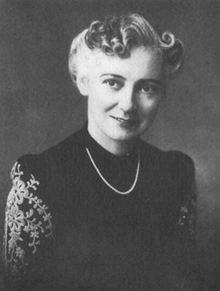Bridget G. MacCarthy
Bridget G. MacCarthy (7 June 1904 – April 1993) was an Irish academic and writer. She has been described as one of the most important female cultural and literary historians.[1]
Bridget G. MacCarthy | |
|---|---|
 | |
| Born | 7 June 1904 Cork |
| Died | April 1993 Cork |
| Occupation | Professor of English |
| Nationality | Ireland |
Biography
Bridget Gerard MacCarthy was born to Jeremiah MacCarthy and Bridget Quinlan of 7 Wellington Square, Cork in 7 June 1904. She was the youngest daughter of four girls and a boy.[2][3] She was educated in University College Cork and completed her BA in 1925. She followed that with an MA in 1927 and went on to do a PhD in Cambridge in 1940 on Women's contribution to the development of the English novel: 1621-1818. MacCarthy worked as a teacher in Edinburgh, in the Craiglockhart Roman Catholic Training College. She then moved on to become a lecturer in the Department of Education in Cork and finished as a Professor of English in University College Cork. She wrote two volumes of The Female Pen which were published in 1944 and 1947. These were her defining works. She did complete several plays and essays and she was published in Studies: An Irish Quarterly Review and The Dublin Magazine. In her personal life she married but she and her husband only lived together for a short time. She lived with her aunt after her mother died. MacCarthy retired in 1966 and gave her entire library away. She died in April 1993.[4][5][6][1][7][8][9][10][11]
Bibliography
- The psychology of genius; studies in Browning, 1936
- The whip hand : a comedy in three acts, 1943
- The female pen : women writers and novelists, 1621-1818, 1944
- Despite fools' laughter; poems, editor, 1944
- Some problems of child welfare, editor, 1945
- The later women novelists, 1744-1818, 1947
- Thackeray in Ireland, 1951
- Women writers : their contribution to the English novel, 1621-1744, 1977
External links
References and sources
- Todd, J. (1998). The Critical Fortunes of Aphra Behn. Literary criticism in perspective. Camden House. p. 66. ISBN 978-1-57113-165-2. Retrieved 2019-11-19.
- "Birth record" (PDF).
- "1911 census".
- "The Female Pen". NYU Press. 2019-01-22. Retrieved 2019-11-19.
- MacCarthy, Bridget G. (2014-04-15). "Women's contribution to the development of the English novel: 1621-1818". CORA Home. Retrieved 2019-11-19.
- MacCarthy, B G. "MacCarthy, B. G.;WorldCat.org". WorldCat.org. Retrieved 2019-11-19.
- Orgis, R. (2016). Narrative Structure and Reader Formation in Lady Mary Wroth's Urania. Taylor & Francis. p. 5. ISBN 978-1-317-09049-6. Retrieved 2019-11-19.
- Bayer, G.; Klitgard, E. (2011). Narrative Developments from Chaucer to Defoe. Routledge Studies in Renaissance Literature and Culture. Taylor & Francis. p. 116. ISBN 978-1-136-82125-7. Retrieved 2019-11-19.
- "Introduction by J Todd" (PDF). University College Cork.
- Letellier, R.I. (2002). The English Novel, 1700-1740: An Annotated Bibliography. Bibliographies and indexes in world literature. Greenwood Press. p. 190. ISBN 978-0-313-31746-0. Retrieved 2019-11-28.
- Harford, J.; Rush, C. (2010). Have Women Made a Difference?: Women in Irish Universities, 1850-2010. Rethinking education. Peter Lang. p. 4. ISBN 978-3-0343-0116-9. Retrieved 2019-11-28.